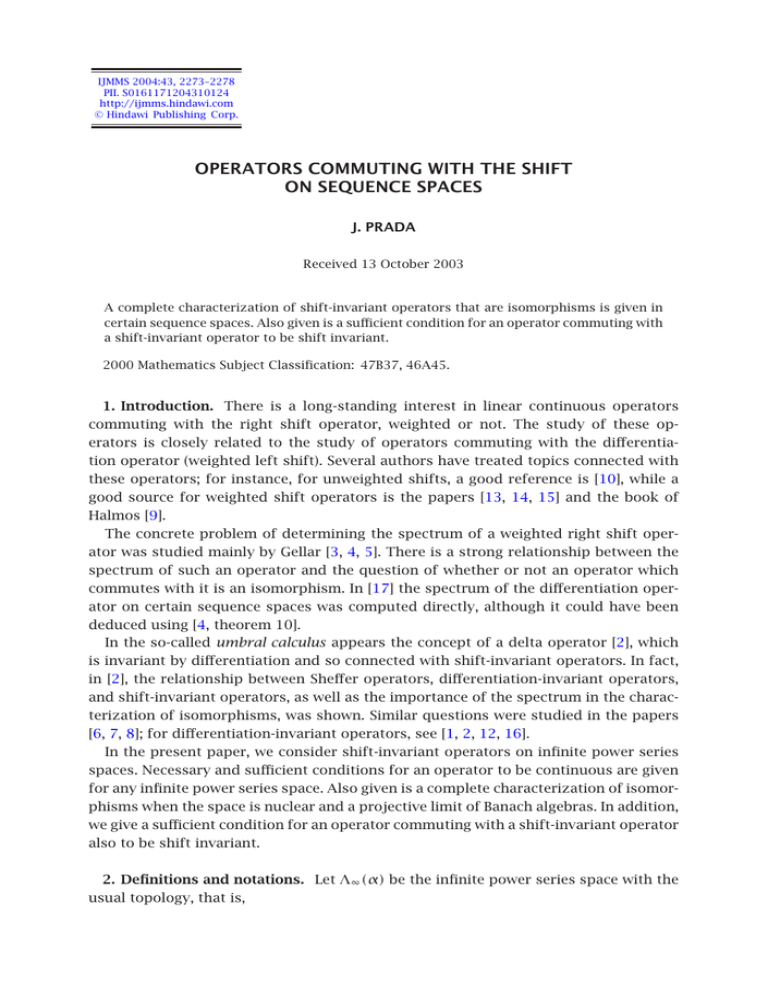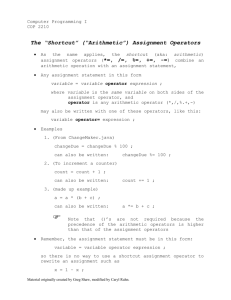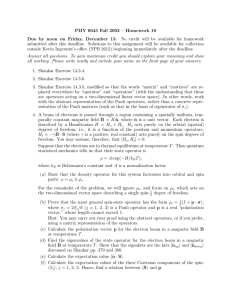OPERATORS COMMUTING WITH THE SHIFT ON SEQUENCE SPACES J. PRADA
advertisement

IJMMS 2004:43, 2273–2278
PII. S0161171204310124
http://ijmms.hindawi.com
© Hindawi Publishing Corp.
OPERATORS COMMUTING WITH THE SHIFT
ON SEQUENCE SPACES
J. PRADA
Received 13 October 2003
A complete characterization of shift-invariant operators that are isomorphisms is given in
certain sequence spaces. Also given is a sufficient condition for an operator commuting with
a shift-invariant operator to be shift invariant.
2000 Mathematics Subject Classification: 47B37, 46A45.
1. Introduction. There is a long-standing interest in linear continuous operators
commuting with the right shift operator, weighted or not. The study of these operators is closely related to the study of operators commuting with the differentiation operator (weighted left shift). Several authors have treated topics connected with
these operators; for instance, for unweighted shifts, a good reference is [10], while a
good source for weighted shift operators is the papers [13, 14, 15] and the book of
Halmos [9].
The concrete problem of determining the spectrum of a weighted right shift operator was studied mainly by Gellar [3, 4, 5]. There is a strong relationship between the
spectrum of such an operator and the question of whether or not an operator which
commutes with it is an isomorphism. In [17] the spectrum of the differentiation operator on certain sequence spaces was computed directly, although it could have been
deduced using [4, theorem 10].
In the so-called umbral calculus appears the concept of a delta operator [2], which
is invariant by differentiation and so connected with shift-invariant operators. In fact,
in [2], the relationship between Sheffer operators, differentiation-invariant operators,
and shift-invariant operators, as well as the importance of the spectrum in the characterization of isomorphisms, was shown. Similar questions were studied in the papers
[6, 7, 8]; for differentiation-invariant operators, see [1, 2, 12, 16].
In the present paper, we consider shift-invariant operators on infinite power series
spaces. Necessary and sufficient conditions for an operator to be continuous are given
for any infinite power series space. Also given is a complete characterization of isomorphisms when the space is nuclear and a projective limit of Banach algebras. In addition,
we give a sufficient condition for an operator commuting with a shift-invariant operator
also to be shift invariant.
2. Definitions and notations. Let Λ∞ (α) be the infinite power series space with the
usual topology, that is,
2274
J. PRADA
∞
kα
n
Λ∞ (α) = xn , xn ∈ C,
< ∞, k = 1, 2, 3, . . . ,
xn e
n=0
(2.1)
∞
kα
xn e n ,
xn =
k
n=0
where α0 ≤ α1 ≤ · · · ≤ αn ≤ · · · → ∞. Λ∞ (α) is a Fréchet space with a canonical basis,
noted by (en ); its topological dual can be identified with the sequence space
Λ×
∞ (α) =
∞
l∞ e−kαn
(2.2)
k=1
and the coordinate operators are continuous. These spaces are nuclear if and only if
∀k,
∃N(k) such that
ekαn
eN(k)αn
∈ l1 .
(2.3)
They are projective limits of the Banach spaces l1 (ekαn ), k ∈ N, which are Banach
algebras (with the convolution multiplication) if and only if there exists C > 0 such that
αn+m ≤ C +αn +αm , for every m and n. Well-known examples of nuclear infinite power
series spaces that are projective limits of Banach algebras are the space H(C) of entire
functions on the complex plane (in this case, αn = n) and s, the space of sequences
rapidly decreasing to zero (for αn = ln n).
S denotes the shift operator S(en ) = en+1 ; it is assumed that S is a continuous operator from Λ∞ (α) to Λ∞ (α), so we have the condition sup αn+1 /αn < ∞.
3. Continuous operators commuting with S
Theorem 3.1. A linear operator T is continuous on Λ∞ (α) and commutes with S if
and only if
T=
∞
ts S s ,
(3.1)
s=0
and satisfies the following condition: for all k, there exists N(k) such that
sup
n
∞
ekαs+n
ts eN(k)αn
s=0
< ∞.
(3.2)
Proof. Observe that the matrix (ts,k )∞
s,k=0 defining T is lower triangular, ts,k = 0,
k > s, and ts,k = ts−k , k ≤ s.
Therefore compute T en for all n and the result follows.
OPERATORS COMMUTING WITH THE SHIFT ON SEQUENCE SPACES
2275
Condition (3.2) can be simplified for certain infinite power series spaces as it is shown
in the propositions below whose proofs are omitted.
Proposition 3.2. Assume that Λ∞ (α) is a nuclear space. Then condition (3.2) is
equivalent to the following one: for all k, there exists N(k) and there exists C(k) > 0 such
that
N(k)αn
ts ≤ C(k) e
,
ekαn+s
∀s, n.
(3.3)
Proposition 3.3. Assume that Λ∞ (α) is a nuclear space and a projective limit of
Banach algebras. Then conditions (3.2) and (3.3) are equivalent to saying that the sequence (ts ) is an element of Λ∞ (α).
Observing that if T commutes with S, T (xs ) = (ts ) ∗ (xs ), where ∗ represents the
convolution product, (or T ( xs zs ) = ts zs · xs zs ) [4, theorem 2], then we have the
following proposition.
Proposition 3.4. If T is a continuous linear operator on Λ∞ (α) commuting with S,
then the function φ(z) = ts zs is holomorphic on a disk whose radius (finite or not) is
greater than or equal to 1.
Proof. If T is continuous, condition (3.3) is true, and so
N(k)α0
ts ≤ C(k) e
,
ekαs
∀s.
(3.4)
Therefore
1/s
lim sup ts ≤ e−k lim inf αs /s .
(3.5)
As lim inf αs /s = 0, or is equal to a number a > 0, or ∞, the result follows.
It is obvious that two operators commuting with S commute with each other [4,
Corollary 1], but it is not true, in general, that if T1 commutes with T2 and T2 commutes
with S, it follows that T1 commutes with S; take T2 = S 2 and T1 given by an infinite
a a01 two-block matrix a00
10 a11 , where a01 , a10 are different from zero and a00 ≠ a11 . We
show in the following proposition that for certain operators T2 the result is true.
Theorem 3.5. Let T2 be a continuous linear operator from Λ∞ (α) to Λ∞ (α) commut∞
ing with S, T2 = s=0 ts S s , verifying the condition that the sequence t (0) = (t1 , t2, t3 , . . .),
t (1) = (0, t1 , t2, t3 , . . .), t (2) = (0, 0, t1 , t2, t3 , . . .), . . . is a basis of the power series space
Λ∞ (α).
Then any linear continuous operator T1 commuting with T2 commutes with S.
Proof. The matrix corresponding to the operator T2 verifies ts,k = 0, k > s, and
ts,k = ts−k , k ≤ s. Then, if (as,k )s,k=0,1,2,... is the matrix of the operator T1 , we have the
2276
J. PRADA
following equations (a consequence of (as,k ) × (ts,k ) = (ts,k ) × (as,k )):
∞
a0,k tk−j,0 = 0,
j = 0, 1, 2, 3, . . . ,
k=j+1
t1,0 a0,j + t0,0 a1,j =
∞
a1,k tk−j,0 ,
j = 0, 1, 2, . . . ,
(3.6)
k=j
t2,0 a0,j + t1,0 a1,j + t0,0 a2,j =
∞
a2,k tk−j,0 ,
j = 0, 1, 2, . . . ,
k=j
and so on.
Observe that the operator given by the matrix (a0,0 , a0,1 , a0,2 , . . .) is continuous because of the continuity of T1 and so an element of Λ×
∞ (α); therefore, as sup αn+1 /αn <
∞, the element (a0,1 , a0,2 , . . .) belongs to Λ×
(α)
too.
As t (0) , t (1) , t (2) , . . . is a basis of
∞
Λ∞ (α), the first set of equations implies that a0,1 = a0,2 = a0,3 = · · · = 0. Then the
second set of equations can be written as
t1,0 a0,j + t0,0 a1,j =
∞
a1,k tk−j,0 ,
j = 0,
k=j
t0,0 a1,j =
∞
(3.7)
a1,k tk−j,0 ,
j = 1, 2, . . . .
k=j
Observing as before that (a11 −a00 , a12 , a13 , . . .) is an element of Λ×
∞ (α) (the operator
given by the matrix (a10 , a11 , a12 , . . . ) is continuous by the continuity of T1 ), it follows
that a11 = a00 , a12 = a13 = a14 = · · · = 0.
Proceeding in an analogous way, the third set of equations can be written as
∞
t2,0 a0,j + t1,0 a1,j + t0,0 a2,j =
a2,k tk−j,0 ,
j = 0,
k=j
t1,0 a1,j + t0,0 a2,j =
∞
a2,k tk−j,0 ,
j = 1,
(3.8)
k=j
t2,0 a0,j + t1,0 a1,j + t0,0 a2,j =
∞
a2,k tk−j,0 ,
j = 2, 3, . . . ,
k=j
and we get a21 = a10 , a22 = a11 , a23 = a24 = · · · = 0.
Thus the operator T1 is given by a matrix that commutes with the matrix of S.
It is then of interest to determine a basis in Λ∞ (α) of the previous form; noting
that t (1) = St (0) , t (2) = St (1) , t (3) = St (2) , . . . , it is enough to find isomorphisms between
infinite power series spaces that commute with S; in fact, given such an isomorphism T ,
it follows that T e0 = t (0) , T e1 = T Se0 = ST e0 = St (0) = t (1) , T e2 = T Se1 = ST e1 = St (1) =
S 2 t (0) = t (2) , . . . and obviously we get a basis.
OPERATORS COMMUTING WITH THE SHIFT ON SEQUENCE SPACES
2277
4. Isomorphisms commuting with S. In this section, we consider isomorphisms between infinite power series spaces (nuclear and projective limits of Banach algebras).
A complete characterization of such isomorphisms that commute with S is given. In
[11], the problem was dealt with for the space of holomorphic functions on a disc and,
in [8], in the study of Sheffer operators, for certain spaces of entire functions.
Theorem 4.1. Assume that Λ∞ (α) is a nuclear space and a projective limit of Banach
algebras; let T be a linear operator commuting with S. Then T is an isomorphism if and
only if any of the following two equivalent conditions is satisfied:
(1) the sequence (ts ) belongs to Λ∞ (α) and (ts ) = e(gs ) , where (gs ) is an element of
Λ∞ (α), that is, (ts ) is an exponential (or invertible) element of the Banach algebra
l1 (ekαn ) for all k,
∞
(2) the sequence (ts ) belongs to Λ∞ (α) and s=0 ts zs ≠ 0 on the maximal ideal space
of the Banach algebra l1 (ekαn ) for all k.
∞
Proof. Assume that the operator T = s=0 ts S s is an isomorphism. Then the oper∞
ator T −1 commutes with S, so T −1 = s=0 rs S s ; as (ts ) and (rs ) belong to Λ∞ (α) and
(ts )∗(rs ) = 1, it follows that (ts ) is an invertible (and exponential) element of all Banach
algebras l1 (ekαn ), for all k (see [2, page 88]).
Conversely, assume that (ts ) belongs to Λ∞ (α) and (ts ) = e(gs ) , (gs ) ∈ Λ∞ (α). Then
∞
the operator T = s=0 ts S s is continuous; as (ts ) is an exponential (invertible) element
∞
of all algebras l1 (ekαn ), taking (rs ) = (ts )−1 , we have that T −1 = s=0 rs S s is continuous,
implying that T is an isomorphism.
Finally, note that conditions (1) and (2) are obviously equivalent as {x ∈ l1 (ekαn ) :
∞
s
ρ
1
kαn
) = exp l1 (ekαn ), where ρ = limn→∞ log ekαn /n
s=0 xs z ≠ 0 for all |z| ≤ e } = inv l (e
(see [2, page 88]).
Observe that lim αn /n = 0 or is equal to a number a > 0. Then the maximal ideal
space of l1 (ekαn ) is, in the first case, the closed disc D(1) (for all k) and, in the second
case, D(eka ). Therefore condition (2) could be reformulated as follows:
∞
(2) the sequence (ts ) belongs to Λ∞ (α) and s=0 ts zs ≠ 0 on D(1) (if lim αn /n = 0)
or on the whole complex plane (if lim αn /n > 0).
Remark 4.2. In the conditions of the previous theorem, any exponential element
of Λ∞ (α) gives a basis; ez is a very simple example, and therefore the operator I +
∞
s
s=1 (1/(s − 1)!)S satisfies the condition of Theorem 3.5.
Remark 4.3. If Λ∞ (α) = H(C), the isomorphisms are given by all entire functions
without zeros on the complex plane; if Λ∞ (α) = s, all elements of s without zeros on
D(1) give isomorphisms (these include, in particular, all nonvanishing holomorphic
functions on a disc with radius greater than 1).
References
[1]
[2]
J. Delsarte and J. L. Lions, Transmutations d’opérateurs différentiels dans le domaine complexe, Comment. Math. Helv. 32 (1957), 113–128 (French).
A. Di Bucchianico, Probabilistic and Analytical Aspects of the Umbral Calculus, CWI Tract,
vol. 119, Centrum voor Wiskunde en Informatica, Amsterdam, 1997.
2278
[3]
[4]
[5]
[6]
[7]
[8]
[9]
[10]
[11]
[12]
[13]
[14]
[15]
[16]
[17]
J. PRADA
R. Gellar, Cyclic vectors and parts of the spectrum of a weighted shift, Trans. Amer. Math.
Soc. 146 (1969), 69–85.
, Operators commuting with a weighted shift, Proc. Amer. Math. Soc. 23 (1969), 538–
545.
, A generalization of weighted shifts, Indiana Univ. Math. J. 24 (1974), 259–264.
S. Grabiner, Weighted shifts and Banach algebras of power series, Amer. J. Math. 97 (1975),
16–42.
, Dense subspaces of entire functions, Michigan Math. J. 33 (1986), no. 3, 417–422.
, Convergent expansions and bounded operators in the umbral calculus, Adv. in Math.
72 (1988), no. 1, 132–167.
P. R. Halmos, A Hilbert Space Problem Book, D. Van Nostrand, New Jersey, 1967.
H. Helson, Lectures on Invariant Subspaces, Academic Press, New York, 1964.
I. I. Ibragimov and N. I. Nagnibida, The matrix method and quasi-power bases in the space
of analytic functions in the disc, Russian Math. Surveys 30 (1975), no. 6, 107–154.
N. I. Nagnibida, Isomorphisms of analytic spaces, commuting with the differentiation operator, Mat. Sb. (N.S.) 72 (114) (1967), 250–260 (Russian).
N. K. Nikol’skiı̆, Invariant subspaces of weighted shift operators, Mat. Sb. (N.S.) 74 (116)
(1967), 172–190 (Russian).
, Unicellularity and non-unicellularity of weighted shift operators, Dokl. Akad. Nauk
SSSR 172 (1967), 287–290 (Russian).
, Basisness and unicellularity of weighted shift operators, Izv. Akad. Nauk SSSR Ser.
Mat. 32 (1968), 1123–1137 (Russian).
J. Prada, Operators commuting with differentiation, Math. Japon. 38 (1993), no. 3, 461–467.
, Delta operators on sequence spaces, Sci. Math. Jpn. 55 (2002), no. 2, 223–231.
J. Prada: Departamento de Matemáticas, Universidad de Salamanca, 37008 Salamanca, Spain
E-mail address: prada@usal.es





